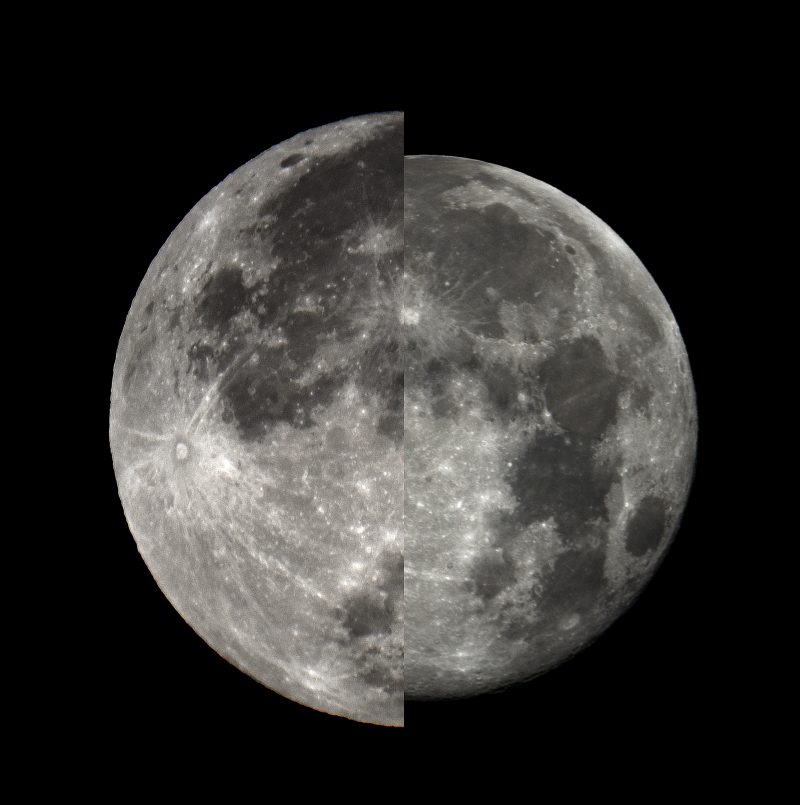The bright star near the moon on April 25 is Spica; read more here.
Around the world, the moon will look full to the eye on the nights of April 26 and 27, 2021. However, the crest of the full moon will fall on April 27 at 03:31 UTC. In United States times zones, that translates to April 26 at 11:31 p.m Eastern, 10:31 p.m. Central, 9:31 p.m. Mountain and 8:31 p.m. Pacific. In North America, we call the April full moon the Pink Moon. This April full moon presents the first in a “season” of three straight full moon supermoons. Overall, this April full moon gives us the second-closest full moon of the year.
Here are the distances (as measured between the centers of the moon and Earth) for the three upcoming full moon supermoons:
Full moon supermoons:
April 27, 2021: 222,212 miles (357,615 km)
May 26, 2021: 222,117 miles (357,462 km)
June 24, 2021: 224,662 miles (361,558 km)
In contrast, the most distant and smallest full moon of the year will fall on December 19, 2021. Sometimes called a micromoon, it’ll be 252,235 miles (405,932 km) away. That’s a whopping 30,118 miles (48,470 km) farther away than the year’s closest and biggest full moon on May 26, 2021.

Visit Sunrise Sunset Calendars to find out when the moon turns full in your time zone. Be sure to check the moon phase box.
Some people prefer to call a full supermoon a perigean full moon. That’s when the full moon and lunar perigee – the moon’s closest point to Earth in its monthly orbit – closely coincide for a few months. This April full moon occurs about 12 hours before the moon sweeps to lunar perigee. Next month, the May full moon will turn full some nine hours after the moon swings to perigee. April and May feature the only two months in 2021 whereby full moon and perigee occur less than 24 hours apart.
What’s more, Earth’s oceans feel the extra pull of these supermoons (full moons near perigee). All full moons (and new moons) combine with the sun to create larger-than-usual tides, called spring tides. But closer-than-average full moons (or closer-than-average new moons) – that is, supermoons – elevate the tides even more. These extra-high spring tides are wide ranging. High tides climb up especially high, and, on the same day, low tides plunge especially low. Experts call these perigean spring tides, in honor of the moon’s nearness. If you live along an ocean coastline, watch for them! They typically follow the supermoon by a day or two.
Do extra-high supermoon tides cause flooding? Maybe yes, and maybe no. Flooding typically occurs when a strong weather system accompanies an especially high spring tide.
When is the next high or low tide? Recommended almanacs here
The recurring cycle of supermoons
The full moon supermoon series of 2021 will recur after 14 lunar months (14 returns to full moon). That’s because 14 returns to full moon almost exactly equal 15 returns to perigee, a period of about one year, one month, and 18 days.
The mean lunar month (full moon to full moon, or new moon to new moon) = 29.53059 days, whereas the mean anomalistic month (perigee to perigee, or apogee to apogee) = 27.55455 days. Hence:
14 lunar months (14 returns to full moon) x 29.53059 days = 413.428 days
15 anomalistic months (15 returns to lunar perigee) x 27.55455 days = 413.318 days
Given that supermoons recur in cycles of 413 days (about one year, one month and 18 days), we can can expect the full moon supermoons to come about one month and 18 days later next year, in 2022.
Full moon distance (June 14, 2022): 222,238 miles or 357,658 km
Full moon distance (July 13, 2022): 222,117 miles or 357,418 km
Full moon distance (August 12, 2022): 224,569 miles or 361,409 km
Bottom line: The whole globe enjoys a full-looking moon on April 26 and 27, 2021. The exact time of full moon falls on the evening of April 26 for the clocks in the mainland United States. It’s the first supermoon of 2021 and second-closest full moon this year. No matter where you live worldwide, watch for the full moon to shine from dusk until dawn.











